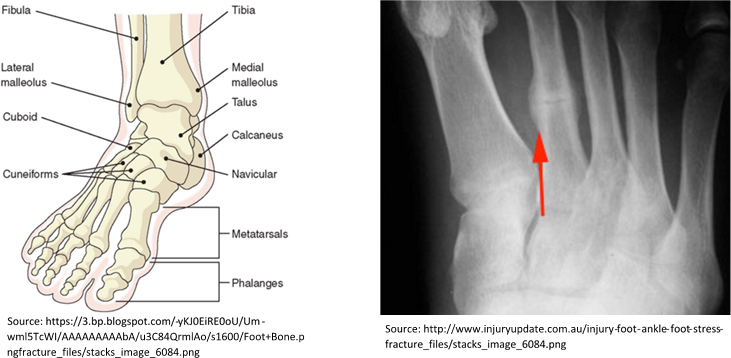Stress fractures are small cracks or severe bruising within the bone. Stress fractures produce a sharp or dull pain at a specific sore spot. The pain worsens during activity, even in normal day to day tasks and is often accompanied by swelling in the area. Stress fractures may also be accompanied by bruising. While stress fracture pain should resolve with rest, if it is left untreated, the pain may continue for longer after activity is ceased and you may experience night pain as well.
Stress fractures are almost always due to overuse from repetitive forces. They commonly occur after a sudden increase in physical activity levels. Other causes may include poor technique, change of playing surface or improper equipment or footwear.
The most commonly affected bones in the foot are: the second and third metatarsals (especially if they are longer than what is considered normal), calcaneus (heel), fibula (outer leg bone), talus (part of your ankle) and the navicular (located at the top of your arch).

Treatment:
- Rest with or without immobilisation. Many stress fractures will require immobilisation of the structure for a period of time. This could be achieved using a removable boot, plaster or a splint of sorts. Whether or not your stress fracture is immobilised, it is important that you rest from any aggravating physical activity completely for 6-8 weeks. It is a good idea to not put weight on that foot for a few weeks by using crutches. Consider a low impact activity such as swimming or cycling to maintain fitness.
- Use ice wrapped in a tea towel for 5-10 minutes several times a day to reduce any swelling.
- Paracetamol (used as directed) can help to manage your pain.
- Your podiatrist may want to send you for x-rays. While they may send you for an x-ray immediately if they are concerned about a true fracture, do not be concerned if they delay the referral. Because stress fractures are due to repetitive stress, the stress fracture is made up of several micro-fractures. This means the stress fracture may not be able to be seen on an x-ray until it starts to heal and bone callous forms. This usually starts to happen after about 2 weeks.
- If an x-ray continues to give a negative diagnosis, an MRI or bone scan may be requested.
- Some stress fractures require surgery. An example is a navicular which has a limited blood supply and so may struggle to heal without surgical intervention.

Comments are closed.